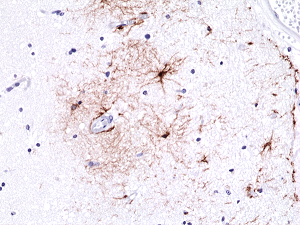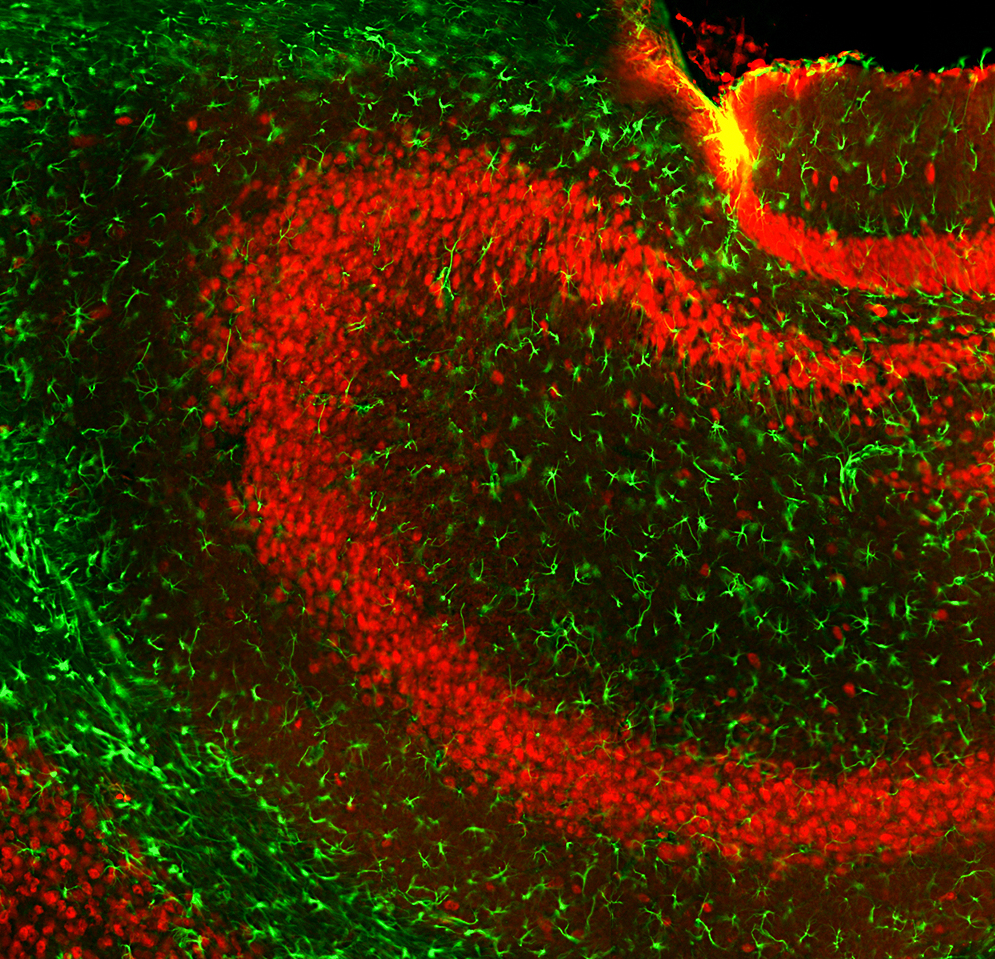
Immunohistochemical staining of formalin fixed and paraffin embedded human brain tissue sections using Anti-GFAP RM246 at a 1:500 dilution.
anti-GFAP, Rabbit Monoclonal (RM246)
REV-31-1127-00
ApplicationsWestern Blot, ImmunoHistoChemistry
Product group Antibodies
ReactivityHuman, Mouse
TargetGFAP
Overview
- SupplierRevMAb Biosciences
- Product Nameanti-GFAP, Rabbit Monoclonal (RM246)
- Delivery Days Customer10
- ApplicationsWestern Blot, ImmunoHistoChemistry
- CertificationResearch Use Only
- ClonalityMonoclonal
- Clone IDRM246
- Gene ID2670
- Target nameGFAP
- Target descriptionglial fibrillary acidic protein
- Target synonymsALXDRD, glial fibrillary acidic protein
- HostRabbit
- IsotypeIgG
- Protein IDP14136
- Protein NameGlial fibrillary acidic protein
- Scientific DescriptionGFAP (Glial fibrillary acidic protein) is a member of the class III intermediate filament protein family. GFAP is expressed in the central nervous system in astrocyte cells. It is involved in many important CNS processes, including cell communication and the functioning of the blood brain barrier. GFAP is heavily and specifically expressed in astrocytes and certain astroglia of the central nervous system, in satellite cells of peripheral ganglia, and in non-myelinating Schwann cells of peripheral nerves. In addition, neural stem cells strongly express GFAP. GFAP is closely related to the other three non-epithelial type III IF family members, vimentin, desmin and peripherin, which are all involved in the structure and function of the cells cytoskeleton. GFAP is thought to help to maintain astrocyte mechanical strength as well as the shape of cells. GFAP is used as a marker to distinguish astrocytes from other glial cells during development. Mutations in this gene cause Alexander disease, a rare disorder of astrocytes in the central nervous system. Alternative splicing of the GFAP gene results in multiple transcript variants encoding distinct isoforms. In addition, many types of brain tumor, presumably derived from astrocytic cells, heavily express GFAP. - Recombinant Antibody. This antibody reacts to human and mouse GFAP (Glial fibrillary acidic protein). Applications: WB, IHC. Source: Rabbit. Liquid. 50% Glycerol/PBS with 1% BSA and 0.09% sodium azide. GFAP (Glial fibrillary acidic protein) is a member of the class III intermediate filament protein family. GFAP is expressed in the central nervous system in astrocyte cells. It is involved in many important CNS processes, including cell communication and the functioning of the blood brain barrier. GFAP is heavily and specifically expressed in astrocytes and certain astroglia of the central nervous system, in satellite cells of peripheral ganglia, and in non-myelinating Schwann cells of peripheral nerves. In addition, neural stem cells strongly express GFAP. GFAP is closely related to the other three non-epithelial type III IF family members, vimentin, desmin and peripherin, which are all involved in the structure and function of the cells cytoskeleton. GFAP is thought to help to maintain astrocyte mechanical strength as well as the shape of cells. GFAP is used as a marker to distinguish astrocytes from other glial cells during development. Mutations in this gene cause Alexander disease, a rare disorder of astrocytes in the central nervous system. Alternative splicing of the GFAP gene results in multiple transcript variants encoding distinct isoforms. In addition, many types of brain tumor, presumably derived from astrocytic cells, heavily express GFAP.
- ReactivityHuman, Mouse
- Storage Instruction-20°C
- UNSPSC12352203





